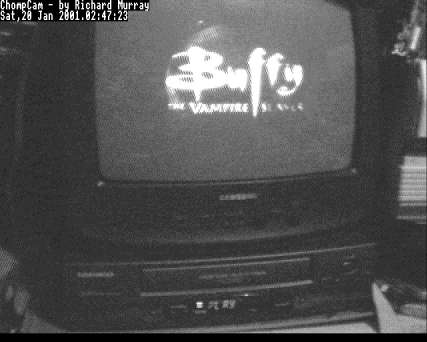Webcam

Webcam |

|

You'll need:
The software is from my original ChompCam, written in 1997. I have removed the Vision assembler code and instead linked in my Digitiser module. The code is a later (more stable) version, and if nothing else, it makes it damn easy to change the code to work with another image grabber like the Eagle M2 or any of the most-excellent WildVision stuff.
I have decided to tidy it up and release it following a report on drobe.co.uk of webcam software, and I remembered I wrote something to do that years ago. It wasn't really practicable back then. However, now with SurfTime and dynamic IP redirection services such as DynDNS, running a webcam on a RISC OS machine is much more viable. I accept that my software has a lot of limitations, thus source is provided. You are more than welcome to hack the hell out of it and turn it into something better. All I ask is you give me a credit somewhere, and please send me a copy of your modified version. Okay? Thanks!
The ChompCam!
=============
Huh?
----
The RISC OS news portal www.drobe.co.uk reported that a RISC OS webcam has
been released, apparently the first of its kind?
Well, it may be the first to do colours and uploading and stuff, but it is
NOT the first publically available webcam for RISC OS. This is!
It's a sort of real-time webcam. It gets the image to the user more or less
"live", served right off the computer. No messing around with ftp uploads...
So where was it?
----------------
It has been on and off of my website. Usually I did a "custom" build for a
person that wanted to use the webcam software. It was never really a "click
here to download" as the code was particularly nasty in places.
Thus, you probably didn't see it. But it's been around since 1997.
So what's new?
--------------
Well, I've removed the digitiser code and replaced it with a call to my
digitiser module.
Help for this is "cgi-bin.chomp.digi_!Help".
What does it do?
----------------
It takes a crappy monochrome image via an HCCS Vision digitiser, and it
processes it (via ChangeFSI) to be a 2/3 size JPEG, which it then shows you.
One of the plus points is the image display form is built on-the-fly as the
image is converted, so that the image will self-load into the viewer's
browser. This is quite cool when seen. :-)
A minus point is direct screen access, so you'll see the picture being
converted. I told you it was a hack!
What you will need
------------------
* A RISC OS computer with a chunk of memory.
This was developed on my A5000 (4Mb), and more recently tested on my
RiscPC (16Mb).
* Stewart Brodie's HTTP server (try www.acornsearch.com ?).
* A Vision digitiser podule (either old with one RAM chip, or the later
ones with 2, it doesn't matter).
* A video source connected to the digitiser.
* An Internet stack.
* A web browser.
Getting going on LocalHost
--------------------------
1. Unpack !HTTPServr and the contents of the "WWWlocal" directory someplace.
2. Set up !HTTPServr:
HTTPServer$Host should be "127.0.0.1"
HTTPServer$Base should point to the "WWWlocal" directory.
The rest is up to you.
3. Get your stack running. For Argonet users, this will work:
RMLoad <VTiInternet$Dir>.Stack.MManager
RMLoad <VTiInternet$Dir>.Stack.Internet
Set INet$HostName 127.0.0.1
Set INet$Resolvers ""
RMLoad <VTiInternet$Dir>.Apps.Web.!Fresco.RMStore.Resolver
<VTiInternet$Dir>.Stack.ifconfig lo0 inet 127.0.0.1 up
4. Run !HTTPServr.
Ensure it says "HTTP Server (80)" in the Application Tasks listing in
your task manager window. If it doesn't, something has gone wrong.
5. Load your browser.
6. Enter the address:
http://127.0.0.1/
or
http://localhost/
(whichever takes your fancy!)
The index page with three items listed should appear. As I am a nice
guy, I've included all three programs - but you probably won't be able
to make use of the cookie unless you have ArcBBS for the cookie file.
7. Click the ChompCam entry.
8. SWITCH IMAGE LOADING ON if you don't do it normally.
Ignore all the rubbish (for now), scroll down to the bottom and hit
"Send request".
The screen should briefly show the received image, an hourglass as CFSI
converts it, then the "ChompCam request" page will appear, shortly
followed by the JPEG image. Yes, I know the sizes were all weird, but
it looks okay in the final output. It's simply an issue with multisync
monitors - the code was written for MODE 15/MODE36. Forget about it...
Cool huh?
How to convert it for other uses
--------------------------------
You're on your own here. Full source is given (well, except for the digitiser
module - but you won't need that). You can modify it for a different video
digitiser, or simply remove the ChompCam references, whatever.
Please, though, credit me in your final dodah.
If you get REALLY stuck, email me.
Easter eggs
-----------
One in the module, none in the other code.
There are two extra images (test work) in the /images directory. :-)
Contacts
--------
support@heyrick.co.uk
http://www.heyrick.co.uk/software/webcam/